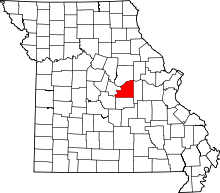Koenig, Missouri
Koenig is an unincorporated community in Osage County, Missouri, in the United States.
History
Originally named Indian Creek for a nearby stream, Koenig was renamed for its postmaster Henry G. King. Koenig is derived from the German word König, meaning "king".[1]
Koenig was located in Section 25 of Township 42W, Range 8N.
In this predominantly German immigrant settlement, Koenig Methodist Church voted to support the Union instead of secession, unlike most of the other Methodist churches in the area.
Koenig had a post office 1892-1920.[2]
At a time in history when churches were an important unit of social organization, German families who settled near Indian Creek before the Civil War organized the Methodist Episcopal Church, which still exists as a Methodist church today.
The church was organized in 1858 by Godfrey (Johann Gottfried) Gieck and Charles (Gottfried Carl) Gieck, authorized through "letters" from a German Methodist Church in Cincinnati, Hamilton County, Ohio. Rev. Hoech of Hermann, Missouri and Godfrey were the first preachers with services held in Godfrey's home. The first church built in 1859 was replaced with a limestone church building on a hilltop in 1879, and this building is in use today supplemented by a modern frame addition. [3]
Koenig Cemetery predated organization of the church by one year, dating from 1857. Ironically one of the earliest burials was of Godfrey Gieck (1810-1859) who acquired a land patent on 240 acres near Indian Creek in 1857. The cemetery, still in use today, is the burial site of many of the earliest settlers, many of whom were born in Germany and acquired land patents before the Civil War.
Another feature of Koenig in its prime was the Koenig Store. Louis Ott (1856-1898), born in Gasconade County, Missouri and son of a German immigrant, opened a blacksmith shop and retail store. After his early death, his wife Mathilda operated the business, later passing on that responsibility to her son Louis. The general store operated into second half of the 20th century.
Transportation affected the settlement, growth, and demise of communities in the Louisiana Purchase and most of the United States. The earliest Indian Creek/Koenig German settlers could travel down the Ohio River, up the Missouri, then up the Osage or Gasconade Rivers. Railroads, the next important form of transportation, bypassed Koenig. Then paved roads augmented and supplanted railroads. No paved road leads to Koenig today. The byway remains gravel as in olden days. Except for a house or two, the village is virtually gone.
References
- ↑ Eaton, David Wolfe (1917). How Missouri Counties, Towns and Streams Were Named. The State Historical Society of Missouri. p. 337.
- ↑ "Historic Towns, Post Offices & Placenames of Gasconade, Maries & Osage Counties". http://www.osagecounty.org/''. Osage County Historical Society. October 17, 2002.
- ↑ History of Cole, Moniteau, Morgan, Benton, Miller, Maries, and Osage Counties, Missouri, Goodspeed Publishing Co., Chicago, 1889.
| |||||||||||||||||||||||||||||
Coordinates: 38°21′22″N 91°46′06″W / 38.35611°N 91.76833°W
